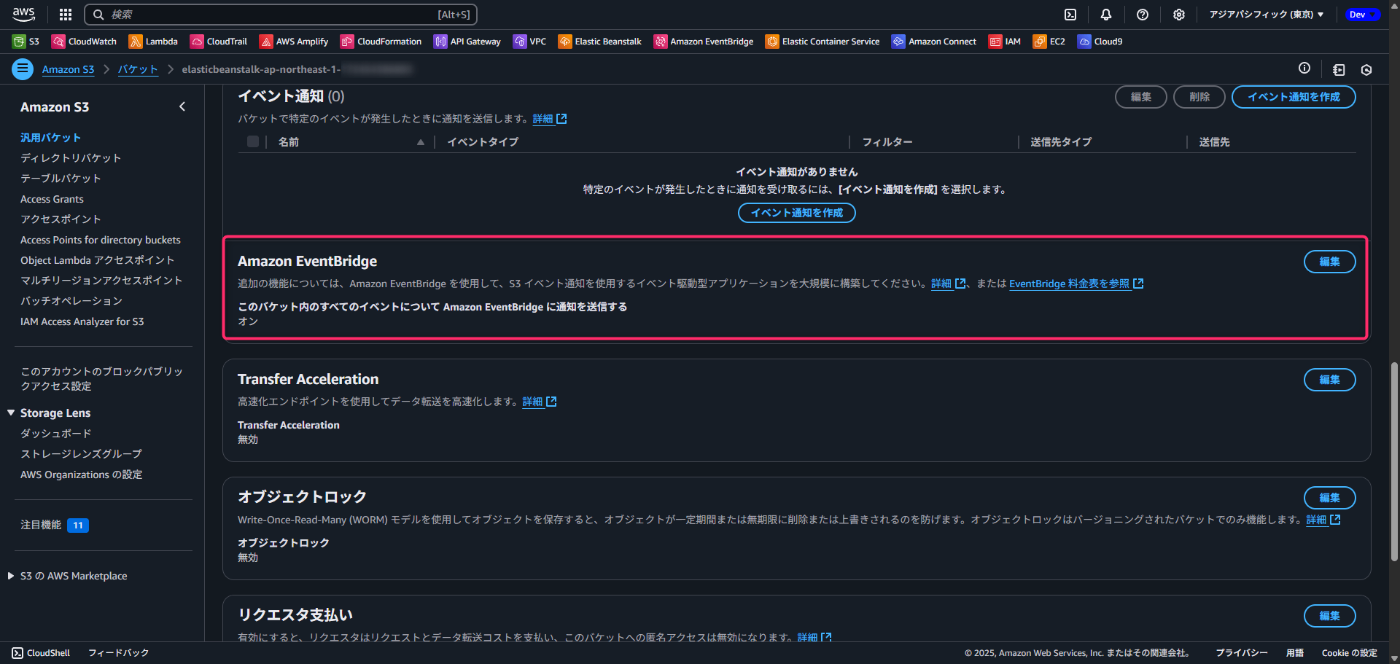📝
Elastic Beanstalk にソースコードをデプロイして更新する処理を Step Functions で自動化してみた
Step Functions のみで完結させてみました。
前提
- コマンド実行環境は CloudShell
- Elastic Beanstalk 環境は作成済み
- プラットフォーム: Node.js 22 running on 64bit Amazon Linux 2023/6.5.2
処理フロー
- ローカル端末で作成したソースバンドルを zip 化
- 1 の zip ファイルを S3 バケットにアップロード
- S3 イベント通知 > EventBridge > Step Functions でステートマシンを実行
- ステートマシンでアプリケーションバージョンの作成と環境の更新を実行
1. ローカル端末で作成したソースバンドルを zip 化
Tutorials and samples - AWS Elastic Beanstalk
今回は上記ドキュメントの Node.js のサンプルを使用しました。
$ wget https://docs.aws.amazon.com/ja_jp/elasticbeanstalk/latest/dg/samples/nodejs.zip
$ unzip nodejs.zip
$ rm nodejs.zip
$ nano index.html
# 任意の内容に書き換え
<h1>From Step Functions</h1>
$ zip sourcebundle.zip *
2. 1 の zip ファイルを S3 バケットにアップロード
この時点では S3 イベント通知を設定していないので、いったんアップロードできるかどうかだけの確認です。
$ aws s3 cp sourcebundle.zip s3://elasticbeanstalk-ap-northeast-1-123456789012/my-app/sourcebundle.zip
$ aws s3 ls s3://elasticbeanstalk-ap-northeast-1-123456789012/my-app/
2025-06-10 01:25:03 4453 sourcebundle.zip
後述の動作検証のためにアップロードしたファイルは削除しておきます。
3. S3 イベント通知 > EventBridge > Step Functions でステートマシンを実行
S3 バケットで EventBridge への通知の送信を有効化します。

以下のステートマシン定義で Step Functions のステートマシンを作成します。
Elastic Beanstalk のアプリケーション名と環境名はハードコードしています。
{
"Comment": "Elastic Beanstalk deployment using Step Functions",
"StartAt": "ExtractS3Info",
"States": {
"ExtractS3Info": {
"Type": "Pass",
"Parameters": {
"bucket.$": "$.detail.bucket.name",
"key.$": "$.detail.object.key",
"timestamp.$": "$$.State.EnteredTime"
},
"Next": "CreateVersionLabel"
},
"CreateVersionLabel": {
"Type": "Pass",
"Parameters": {
"bucket.$": "$.bucket",
"key.$": "$.key",
"versionLabel.$": "States.Format('v-{}', $.timestamp)"
},
"Next": "CreateApplicationVersion"
},
"CreateApplicationVersion": {
"Type": "Task",
"Resource": "arn:aws:states:::aws-sdk:elasticbeanstalk:createApplicationVersion",
"Parameters": {
"ApplicationName": "test",
"VersionLabel.$": "$.versionLabel",
"Description.$": "States.Format('Version {} deployed from Step Functions', $.versionLabel)",
"SourceBundle": {
"S3Bucket.$": "$.bucket",
"S3Key.$": "$.key"
},
"AutoCreateApplication": false
},
"ResultPath": "$.createVersionResult",
"Next": "Wait10Seconds"
},
"Wait10Seconds": {
"Type": "Wait",
"Seconds": 10,
"Next": "UpdateEnvironment"
},
"UpdateEnvironment": {
"Type": "Task",
"Resource": "arn:aws:states:::aws-sdk:elasticbeanstalk:updateEnvironment",
"Parameters": {
"ApplicationName": "test",
"EnvironmentName": "Test-env",
"VersionLabel.$": "$.versionLabel"
},
"ResultPath": "$.updateEnvironmentResult",
"Next": "Success"
},
"Success": {
"Type": "Pass",
"Parameters": {
"statusCode": 200,
"message.$": "States.Format('Successfully deployed version {} to Test-env', $.versionLabel)",
"deployedVersion.$": "$.versionLabel",
"createVersionResult.$": "$.createVersionResult",
"updateEnvironmentResult.$": "$.updateEnvironmentResult"
},
"End": true
}
}
}
ステートマシンの実行ロールには AdministratorAccess 権限を付与しました。
EventBridge ルールで以下のイベントパターンを定義します。
{
"source": ["aws.s3"],
"detail-type": ["Object Created"],
"detail": {
"bucket": {
"name": ["my-bucket-name"]
}
}
}
- ステートマシンでアプリケーションバージョンの作成と環境の更新を実行
再度 S3 バケットにソースバンドルをアップロードして動作確認します。
$ aws s3 cp sourcebundle.zip s3://elasticbeanstalk-ap-northeast-1-123456789012/my-app/sourcebundle.zip
ステートマシンの実行が成功し、Elastic Beanstalk 環境が更新されていれば成功です。



エラーが発生した場合はステートマシンの実行ログを確認してください。
まとめ
今回は Elastic Beanstalk にソースコードをデプロイして更新する処理を Step Functions で自動化してみました。
どなたかの参考になれば幸いです。
Discussion